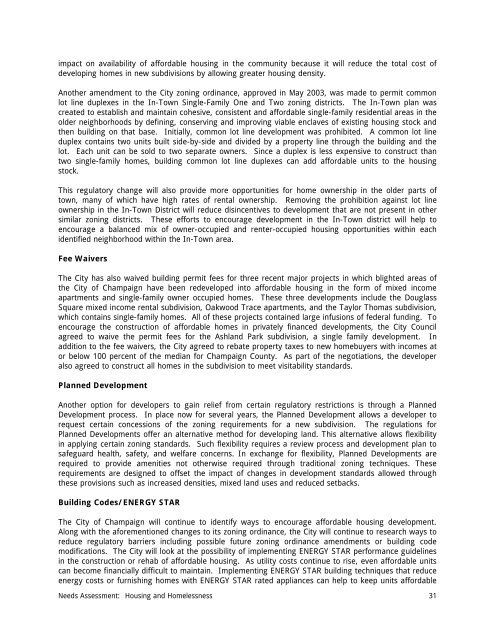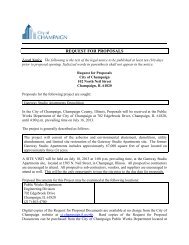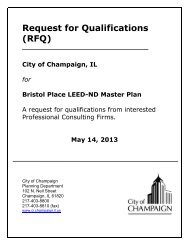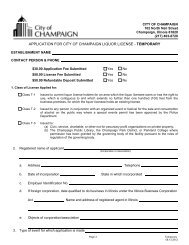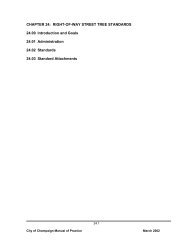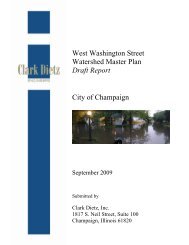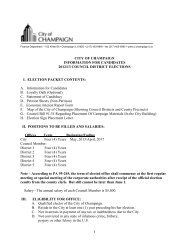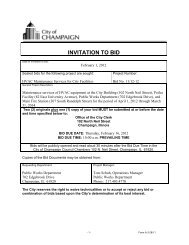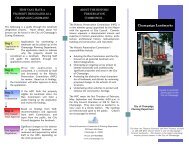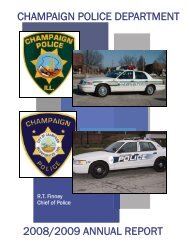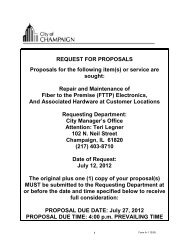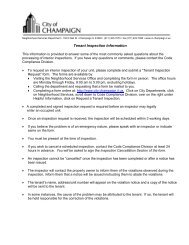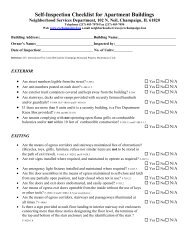2010-2014 Consolidated Plan - City of Champaign
2010-2014 Consolidated Plan - City of Champaign
2010-2014 Consolidated Plan - City of Champaign
You also want an ePaper? Increase the reach of your titles
YUMPU automatically turns print PDFs into web optimized ePapers that Google loves.
impact on availability <strong>of</strong> affordable housing in the community because it will reduce the total cost <strong>of</strong>developing homes in new subdivisions by allowing greater housing density.Another amendment to the <strong>City</strong> zoning ordinance, approved in May 2003, was made to permit commonlot line duplexes in the In-Town Single-Family One and Two zoning districts. The In-Town plan wascreated to establish and maintain cohesive, consistent and affordable single-family residential areas in theolder neighborhoods by defining, conserving and improving viable enclaves <strong>of</strong> existing housing stock andthen building on that base. Initially, common lot line development was prohibited. A common lot lineduplex contains two units built side-by-side and divided by a property line through the building and thelot. Each unit can be sold to two separate owners. Since a duplex is less expensive to construct thantwo single-family homes, building common lot line duplexes can add affordable units to the housingstock.This regulatory change will also provide more opportunities for home ownership in the older parts <strong>of</strong>town, many <strong>of</strong> which have high rates <strong>of</strong> rental ownership. Removing the prohibition against lot lineownership in the In-Town District will reduce disincentives to development that are not present in othersimilar zoning districts. These efforts to encourage development in the In-Town district will help toencourage a balanced mix <strong>of</strong> owner-occupied and renter-occupied housing opportunities within eachidentified neighborhood within the In-Town area.Fee WaiversThe <strong>City</strong> has also waived building permit fees for three recent major projects in which blighted areas <strong>of</strong>the <strong>City</strong> <strong>of</strong> <strong>Champaign</strong> have been redeveloped into affordable housing in the form <strong>of</strong> mixed incomeapartments and single-family owner occupied homes. These three developments include the DouglassSquare mixed income rental subdivision, Oakwood Trace apartments, and the Taylor Thomas subdivision,which contains single-family homes. All <strong>of</strong> these projects contained large infusions <strong>of</strong> federal funding. Toencourage the construction <strong>of</strong> affordable homes in privately financed developments, the <strong>City</strong> Councilagreed to waive the permit fees for the Ashland Park subdivision, a single family development. Inaddition to the fee waivers, the <strong>City</strong> agreed to rebate property taxes to new homebuyers with incomes ator below 100 percent <strong>of</strong> the median for <strong>Champaign</strong> County. As part <strong>of</strong> the negotiations, the developeralso agreed to construct all homes in the subdivision to meet visitability standards.<strong>Plan</strong>ned DevelopmentAnother option for developers to gain relief from certain regulatory restrictions is through a <strong>Plan</strong>nedDevelopment process. In place now for several years, the <strong>Plan</strong>ned Development allows a developer torequest certain concessions <strong>of</strong> the zoning requirements for a new subdivision. The regulations for<strong>Plan</strong>ned Developments <strong>of</strong>fer an alternative method for developing land. This alternative allows flexibilityin applying certain zoning standards. Such flexibility requires a review process and development plan tosafeguard health, safety, and welfare concerns. In exchange for flexibility, <strong>Plan</strong>ned Developments arerequired to provide amenities not otherwise required through traditional zoning techniques. Theserequirements are designed to <strong>of</strong>fset the impact <strong>of</strong> changes in development standards allowed throughthese provisions such as increased densities, mixed land uses and reduced setbacks.Building Codes/ENERGY STARThe <strong>City</strong> <strong>of</strong> <strong>Champaign</strong> will continue to identify ways to encourage affordable housing development.Along with the aforementioned changes to its zoning ordinance, the <strong>City</strong> will continue to research ways toreduce regulatory barriers including possible future zoning ordinance amendments or building codemodifications. The <strong>City</strong> will look at the possibility <strong>of</strong> implementing ENERGY STAR performance guidelinesin the construction or rehab <strong>of</strong> affordable housing. As utility costs continue to rise, even affordable unitscan become financially difficult to maintain. Implementing ENERGY STAR building techniques that reduceenergy costs or furnishing homes with ENERGY STAR rated appliances can help to keep units affordableNeeds Assessment: Housing and Homelessness 31


